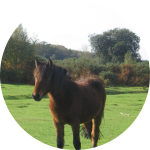|
Trying to pin down the moment at which horse and human history
were first entwined is like trying to name the inventor of
the wheel. The domesticated horse looms so large in human
culture, and casts its shadow from so far back in time, that
we may never know much about its origins.
We can say that the horse's first confirmed appearance in
human culture is a dramatic one: the still-haunting Paleolithic
cave art of 30,000 BCE, of the sort found in places such as
Lascaux, France (though the estimated date for Lascaux's paintings
is closer to 16,000 years old). But these were wild horses,
hunted in all likelihood for meat.
The next clear picture we have - no pun intended - comes from
evidence of chariot burials around 2000 BCE, though evidence
is mounting to suggest a date slightly further back: in the
Eurasian steppes of 4000 BCE.
In that rough, cold, open environment (centered on what is
now Ukraine), archaeologists find evidence of the use of bits
in the 6000-year-old remains of horse teeth. (Other evidence
from this era and area includes the appearance of horse bones
in human graves - apparently cowboys weren't the first to
insist on being buried with their loyal steeds.)
A bit later in the archaeological record - 2500-2000 BCE,
in Hungary - we find remains of horses whose size, as well
as the range of physical variation between each other, attest
to the likelihood that horse breeding and breaking was already
affecting the species' evolution.
By this point in history, evidence of widespread domestication
of horses already abounds: breastplate harnesses, an expansion
in the horse's geographic area (perhaps suggesting human adoption
of the animals), references to horseback writing in ancient
Mesopotamian documents, and, less appetizingly, layers of
concentrated horse poop (suggesting the presence of corrals,
unless ancient wild horses naturally observed the same group-bathroom-use
practices as contemporary American women visiting dance clubs).
Though much of this evidence arises over a large area in a
small space of time, suggesting a picture of many contemporaneous
but unrelated breakthroughs in horse domestication rather
than one culture "discovering" the horse's usefulness and
teaching this secret to others, it's still possible that one
particular culture got there, so to speak, before all others.
It may have been the Botai culture of Kazhakstan (3500-3000
BCE) - their garbage deposits contain a great many more horse
bones than do those of any previous known culture, suggesting
that they had more success in hunting wild horses for food,
which would seemingly require rudimentary transportation technology,
such as, well, horses to ride! On the other hand, say some
archaeologists, they may have done their hunting on foot.
Another candidate may be the people who inhabited the coastal
steppes of Ukraine north of the Danube delta; these folks'
graves include beads made of horses' teeth, plus polished
stone mace-heads sculpted into the shape of horse heads. (But,
as we know already from those gorgeous Lascaux cave paintings,
the use of horses as symbols of grace, beauty, power, probably
predates their domestication by a healthy distance.)
Finally, there are the Khvalynsk people of the Volga region
of present-day Russia, whose graves yield evidence of ritual
sacrifices of horses (wild or not?) as long ago as 4800-4400
BCE. (Some even suggest that the Botai learned what they knew
from neighboring Khvalynsk.)
Another intriguing scenario: prehistoric horses were once
widespread in modern-day North America, but they all died
out around 8000-9000 BCE. The modern horse is entirely descended
from those ancient pre-horse species who crossed from American
to Eurasia before the last Ice Age, and, given that the same
environmental stressors thought to have killed off the American
horse were also felt, to a lesser extent, in Eurasia, it's
possible that horses would have died off there too had they
not been domesticated.
An especially ironic possibility, this, especially in light
of another, unrelated theory: that the North American horse
died as a direct result of humanity's emergence - they were
hunted to death. Perhaps humanity took away with one hand
and gave with another.
About the Author
TRP Services
offers Thoroughbred horse racing and horse racing tips online
for horse racing handicapping and those who love thoroughbred
horses for the horse racing tracks.
|


